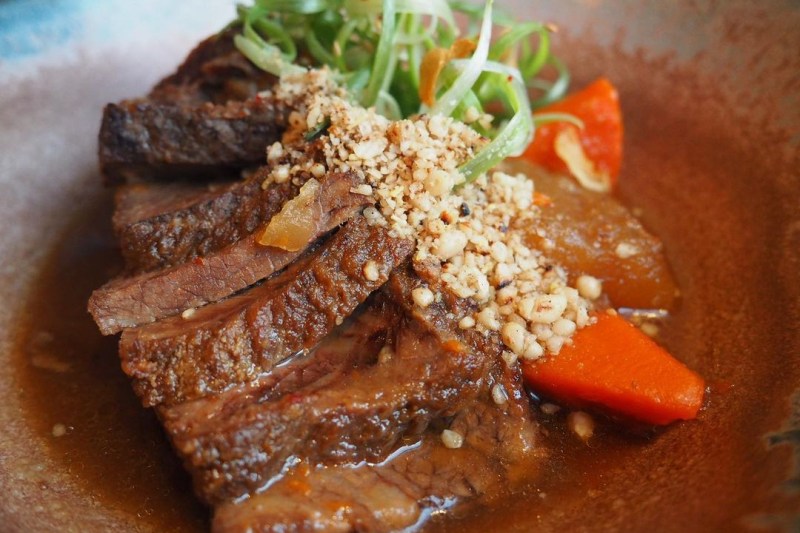Korean galbi-jjim, a rich stew of beef short ribs and vegetables, is one of the best cold-weather dishes in the world. Slightly sweet with a deeply flavored base of soy and sesame, this show-stopping dish is perfect for a freezing winter day. Traditionally a high-end dish in Korean cuisine due to the inclusion of beef, galbi-jjim has become the celebratory dish for many Korean gatherings. Be warned: galbi-jjim is time-consuming and best attempted on a weekend where’s there’s plenty of time to cook and enjoy.
 Preparing the Meat
Preparing the Meat
While most people familiar with Korean food are acquainted with the grilled short ribs of Korean barbecue, galbi-jjim uses those same short ribs in a luscious braise. Modern Korea has become famous for beef and historically this meat was reserved for royalty and the upper class. Even in modern Korea, galbi-jjim is usually a signifier of a special occasion such as celebrations or holidays.

Be sure to buy large chunks of short ribs for this recipe and not the flanken or LA cut of short ribs (thin, cross-cut) that’s suited for barbecue. Korean grocery stores will have short ribs butchered specifically for galbi-jjim in the meat section. If that isn’t an option, buy English cut short ribs from your local butcher. This cut of short rib is meant for long braises and will be suitable for galbi-jjim.
There are two key steps to the beef preparation of galbi-jjim that should not be skipped — soaking the ribs in cold water and an initial boil. These critical steps are important for removing the impurities (the blood) that occur naturally in the beef. To do this, first, soak the ribs in cold water for at least 30 minutes before straining. Then, the ribs should be boiled with clean water and strained again, this time reserving the broth. Without these steps, the stew can be gamey, lacking the clean taste of a properly prepared galbi-jjim.
Galbi-jjim (Korean Braised Short Rib) Recipe

This galbi-jjim recipe is courtesy of Andrew Lim, the chef of Chicago’s Perilla. Recently awarded a Bib Gourmand award for 2021, Perilla is named after the resilient plant native to Korea and an homage to the immigrant parents of Chef Lim and his managing partner, Thomas Oh. Lim’s goal for Perilla is to showcase Korean cuisine in a new light, with high-end ingredients and unconventional techniques.
Like many Korean Americans, galbi-jjim was a special occasion dish for Lim growing up.
“At my family holiday gatherings, the turkey was secondary,” said Lim. “The galbi-jjim — it was always the star of the show. It was rare that we would have this incredible dish on our dinner table unless it was a birthday or major holiday. So the sight of that large platter of glistening braised short ribs, bright beautiful vegetables, chestnuts, and sesame seeds was always a huge treat for the family!”
Although Lim is proud of this recipe, he still believes his mother’s recipe is the champion, and “this is my attempt to do her recipe some honor.” Lim recommends enjoying galbi-jjim with white rice accompanied by plenty of kimchi and banchan (Korean sides dishes).
Prep Time: 45 minutes
Total Cook Time: 1 hour 45 minutes
Yield: 3 to 4 people
For Stew:
Ingredients:
- 3-4 large beef short rib pieces
- 1-2 large carrots
- ½ whole large daikon radish
For Traditional Garnishes (Optional):
- 8-10 pieces of chestnuts (peeled)
- 8-10 pieces dried jujube
- 2 tablespoon pine nuts
- 12-15 pieces gingko nuts
- 1 tbsp sesame seeds
- 1 tbsp scallions, sliced
For Sauce:
- 1 tsp ginger
- 4 cloves garlic
- ½ medium onion
- 8 ounces granny smith apple and/or Korean pear (half and half if possible)
- 8 tbsp soy sauce
- 4 tbsp sugar
- 1 tbsp sesame oil
- 1 tsp salt
- .25 cup sake, rice wine, or mirin
- 1 tsp black pepper
Method:
- Place the short ribs in cold water for 30-45 minutes to remove some of the impurities and blood. Set aside.
- While beef is in cold water, place ginger, garlic, onion, apple/pear, sugar, salt, sesame oil, sake/rice wine/mirin, soy sauce, and black pepper into a food processor or blender. Blend until smooth or slightly chunky (if chunks are too big, blend again). Place in bowl and set aside.
- Cut carrots and radish into large 1.5-2 inch pieces or cubes. Set aside.
- After 30-45 minutes, discard cold water from short ribs. Place short ribs in a large pot and fill with water, about an inch above the beef. Heat until boiling, then lower the heat and simmer for 15 minutes.
- Turn off the heat and strain the boiled beef stock from the meat and set both aside. Rinse off the short ribs, trimming off excess fat.
- Place beef back into the pot and add 3-4 cups of the strained beef stock water and sauce. Cover and bring stew up to a simmer for 1 hour, or until beef is tender but does not fall off the bone.
- After one hour, add the cubes of carrots and radish to the pot (8-12 pieces of each). If using, add ginkgo, chestnuts, jujubes at this step (the addition of these ingredients will enrich both the flavor and texture of the stew). Simmer for another 30 minutes, or until vegetables are softened and cooked through.
- Taste the sauce, if you want more salt or sugar add more depending on your flavor preference. The sauce should be rich and thickened. If it’s too watery, let the short ribs and sauce simmer uncovered for another 10 minutes or so. The meat should barely fall off the bone but not so tender that it slides off on its own.
- Turn off heat and garnish with sesame seeds, pine nuts, and scallions.
- Enjoy with steamed rice and banchan (like kimchi!).
 Preparing the Meat
Preparing the Meat


